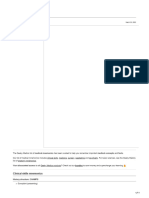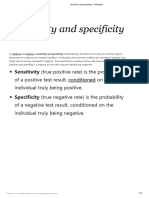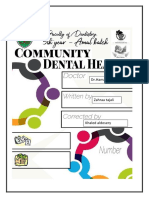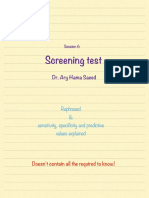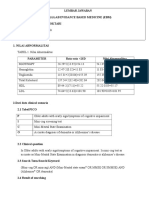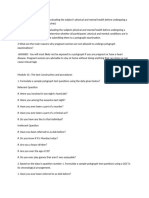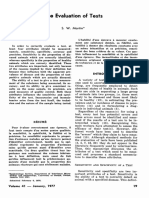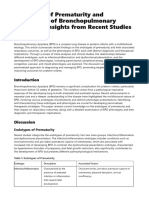SpIn SnOut
SpIn SnOut
Uploaded by
Aj GenoCopyright:
Available Formats
SpIn SnOut
SpIn SnOut
Uploaded by
Aj GenoCopyright
Available Formats
Share this document
Did you find this document useful?
Is this content inappropriate?
Copyright:
Available Formats
SpIn SnOut
SpIn SnOut
Uploaded by
Aj GenoCopyright:
Available Formats
From clinical point of view, it is very important to understand the concept of sensitivity and specificity of
a test.
Sensitivity: The % of the time that it is what it says it is!
Suppose 10 subjects were screened for a test. In reality all 10 did have the disease but the test came
back positive only for 8 people. This test failed to catch 2 people who had the disease. Test showed false
negative tests for those two persons. This test is only 80 % sensitive.
Sensitivity is calculated by the following formula: True positives/True positives+False negative
An ideal test will have a high sensitivity meaning it will catch all people with a disease. If a test has a low
sensitivity, it wouldn't be reliable because as a clinician based on a false negative, you will tell your
patient that he/she does not have the disease while in reality he/she is diseased. Its like letting loose a
real criminal.
A sensitivity of 100% means that the test recognizes all actual positives - for example, all sick people are
recognized as being ill. Thus, negative results in a high sensitivity test are used to rule out the disease.
A test with a high sensitivity has a low type II error rate (giving a false negative).
Thus…
SnOUT: If a highly Sensitive test says it’s OUT…ITS OUT! (if the test comes back negative, they don’t
have it!)
Specificity: The % of the time that it isn’t what it says it isn’t!
Suppose 10 persons were tested for a disease and all 10 people came positive for that disease. In reality,
only 8 people had the disease. The two people who came back positive do not have the disease in
reality. They have some other condition that gives a false positive.
If a test has a low specificity, it is not reliable because it will give false positive results.
The formula for specificity is: True negative/true negative+False positive
A specificity of 100% means that the test recognizes all actual negatives - for example, all healthy people
will be recognized as healthy. Because 100% specificity means no positives are erroneously tagged, a
positive result in a high specificity test is used to confirm the disease. The maximum can trivially be
achieved by a test that claims everybody healthy regardless of the true condition. Therefore, the
specificity alone does not tell us how well the test recognizes positive cases. We also need to know the
sensitivity of the test.
A test with a high specificity has a low type I error rate (giving a false positive).
An example of a test that is not very specific is VDRL and RPR (syphilis diagnostic tests). These tests show
positive results for SLE (systemic lupus erythematosus).
Thus…
SpIN: use a Specific test to rule in a hypothesis. ( If you get a positive test, you can count on it being a
true positive.)
PS: On Journal article comparisons of two means: If the probability level is 0.5 or less (p<0.05), there is
a statistically significant difference between the two means.
You might also like
- Study Guide - The Nature of Disease Pathology For The Health Profession 2nd Ed - Paulson AK CH 01Document7 pagesStudy Guide - The Nature of Disease Pathology For The Health Profession 2nd Ed - Paulson AK CH 01Tony Ansah100% (1)
- The Autoimmune Solution: Prevent and Reverse the Full Spectrum of Inflammatory Symptoms and DiseasesFrom EverandThe Autoimmune Solution: Prevent and Reverse the Full Spectrum of Inflammatory Symptoms and DiseasesRating: 4.5 out of 5 stars4.5/5 (21)
- Medical MnemonicsDocument11 pagesMedical Mnemonicshelpnb2No ratings yet
- WK 13 HWDocument7 pagesWK 13 HWKinuPatel100% (2)
- Divine Intervention Episode 143 (USMLE Biostats Review) : Some ResidentDocument52 pagesDivine Intervention Episode 143 (USMLE Biostats Review) : Some Residentsusannahshiny100% (3)
- Fibrocystic Breast DiseaseDocument3 pagesFibrocystic Breast Diseasebadshah007777No ratings yet
- 12 30 11 AADE Insulin WhitePaper PrintDocument17 pages12 30 11 AADE Insulin WhitePaper PrintMiguel Angel Fonseca RiveraNo ratings yet
- Evidence-Based Diagnosis: II. Sensitivity and SpecificityDocument4 pagesEvidence-Based Diagnosis: II. Sensitivity and SpecificityKaticaVarelaNo ratings yet
- Glossary Concepts - Sensitivity, Specificity & Likelihood RatiosDocument4 pagesGlossary Concepts - Sensitivity, Specificity & Likelihood RatiosJing CruzNo ratings yet
- A Medical TestDocument10 pagesA Medical TestEmmanuella OkeaforNo ratings yet
- Diagnostic Screening Tests-ToolsDocument26 pagesDiagnostic Screening Tests-Toolskato.mp2040No ratings yet
- Sensitivity and Specificity - WikipediaDocument31 pagesSensitivity and Specificity - WikipediawordpressavvyNo ratings yet
- Avian Influenza Epidemiology: Concepts & Applications of Clinical and Serological TestingDocument8 pagesAvian Influenza Epidemiology: Concepts & Applications of Clinical and Serological TestingalampandulangNo ratings yet
- Biostatistics Lecture 3Document18 pagesBiostatistics Lecture 3qazi khanzlaNo ratings yet
- Diagnostic Test 1Document4 pagesDiagnostic Test 1aryawiraNo ratings yet
- Screening For Disease PPT HadeelDocument10 pagesScreening For Disease PPT Hadeelalihaiderinad0No ratings yet
- Diagnostic Testing-1Document45 pagesDiagnostic Testing-1Ali HassanNo ratings yet
- 4 Sheet BiostatDocument8 pages4 Sheet BiostatHanin AkNo ratings yet
- Sensitivity Vs SpecificityDocument16 pagesSensitivity Vs SpecificitydwataNo ratings yet
- Probability Cheat SheetDocument3 pagesProbability Cheat SheetAmishaNo ratings yet
- ScreeningDocument40 pagesScreeningDhrubajyoti Sen100% (1)
- Sensitivity and SpecificityDocument3 pagesSensitivity and SpecificityPrisia AnantamaNo ratings yet
- Sti Case StudyDocument2 pagesSti Case StudyJulia BrownNo ratings yet
- Seminar I Otest Pulp Are SDocument47 pagesSeminar I Otest Pulp Are SAngel RamirezNo ratings yet
- ENG - Epidemiology Biostatistics IMGDocument8 pagesENG - Epidemiology Biostatistics IMGManivanh AvalosNo ratings yet
- Validity of Screening TestDocument12 pagesValidity of Screening Testaritramarrow29No ratings yet
- Sensitivity Specificity PPV and NPVDocument4 pagesSensitivity Specificity PPV and NPVمحمد حسنNo ratings yet
- Glossary Sensitivity and SpecificityDocument1 pageGlossary Sensitivity and SpecificityJing CruzNo ratings yet
- Biostatistics 22003Document35 pagesBiostatistics 22003god4alllNo ratings yet
- Screening Tests by BastaDocument14 pagesScreening Tests by BastaKanar MahmoodNo ratings yet
- 09 ScreeningDocument49 pages09 Screeningmuhammadshahzeb.engrNo ratings yet
- HIV Councelling (OSCE) Pre-Test CounsellingDocument2 pagesHIV Councelling (OSCE) Pre-Test Counsellingkeithan96No ratings yet
- Jurnal Sensitivitas & SpesifisitasDocument9 pagesJurnal Sensitivitas & SpesifisitasIntan CheeryNo ratings yet
- Screening For DiseasesDocument7 pagesScreening For DiseasesArrow AnalyticaNo ratings yet
- Diagnostic Test EvaluationDocument95 pagesDiagnostic Test EvaluationADUGNA DEGEFENo ratings yet
- Experimental Error HTTPDocument6 pagesExperimental Error HTTPHamim SudarsonoNo ratings yet
- Screening: Department of Public Health Medical School, University of PécsDocument38 pagesScreening: Department of Public Health Medical School, University of PécsESSA GHAZWANI100% (1)
- Epidemiology Lect.1Document6 pagesEpidemiology Lect.1sohaib197No ratings yet
- Epi CHPTR 8 To 11Document74 pagesEpi CHPTR 8 To 11Loai Mohammed IssaNo ratings yet
- Skill Lab Ebm TaryDocument15 pagesSkill Lab Ebm TarykemastasrifNo ratings yet
- Template SlideDocument39 pagesTemplate SlideAndrei BerdichewskyNo ratings yet
- Numbers Can Be Deceiving... Even Wrong SometimesDocument2 pagesNumbers Can Be Deceiving... Even Wrong SometimesDylan SickichNo ratings yet
- 105, Lecture 11, SU20Document63 pages105, Lecture 11, SU20JakNo ratings yet
- ScreeningDocument41 pagesScreeningReham M NagatyNo ratings yet
- Beyond Informed ConsentDocument5 pagesBeyond Informed ConsentParcalabu LaurentiuNo ratings yet
- 09_LaboratoryMedicine_DiagnostcTests_21.11.24 (1)Document6 pages09_LaboratoryMedicine_DiagnostcTests_21.11.24 (1)Omer BelfaqihNo ratings yet
- Herpes Blood TestsDocument1 pageHerpes Blood TestsApril FoleyNo ratings yet
- Lecture 8 ReKm Test of Significance HypothesisDocument17 pagesLecture 8 ReKm Test of Significance Hypothesisrayta.rahmanNo ratings yet
- How To Read A Paper Papers That Report Diagnostic or Screening TestsDocument4 pagesHow To Read A Paper Papers That Report Diagnostic or Screening TestsFabricio EguíaNo ratings yet
- Herpes Serology: Remember Royal Adelaide Hospital For More InformationDocument2 pagesHerpes Serology: Remember Royal Adelaide Hospital For More InformationYosi PermanaNo ratings yet
- CEBM Diagnostic Study Appraisal Worksheet TranslateDocument5 pagesCEBM Diagnostic Study Appraisal Worksheet TranslateFitriArdiningsih100% (1)
- Module 9-16Document6 pagesModule 9-16Julius AbellaNo ratings yet
- Epi-Lessons 5Document44 pagesEpi-Lessons 5Najeeb haiderNo ratings yet
- Screening in Public HealthDocument8 pagesScreening in Public HealthiisiseuNo ratings yet
- The Evaluation: of TestsDocument7 pagesThe Evaluation: of TestsFitraAshariNo ratings yet
- Compmed00033 0023 PDFDocument7 pagesCompmed00033 0023 PDFFitraAshariNo ratings yet
- Biostatistics PDFDocument20 pagesBiostatistics PDFneilroymNo ratings yet
- EMS LawsuitsDocument9 pagesEMS LawsuitsIlyes FerenczNo ratings yet
- Tutorial 9 PDFDocument6 pagesTutorial 9 PDFPututWisnuNugrohoNo ratings yet
- Tutorial Wk10 HLTH2024 RMIH 2022autDocument16 pagesTutorial Wk10 HLTH2024 RMIH 2022autalana.gordon24No ratings yet
- Cure Herpes in Nature’s Corner: Natural Cures for a Herpes Free LifeFrom EverandCure Herpes in Nature’s Corner: Natural Cures for a Herpes Free LifeRating: 5 out of 5 stars5/5 (38)
- Pil 2203Document4 pagesPil 2203Codii GamingNo ratings yet
- (Molecular and Translational Medicine) Alan H.B. Wu, Kiang-Teck J. Yeo-Pharmacogenomic Testing in Current Clinical Practice_ Implementation in the Clinical Laboratory (Molecular and Translational MediDocument288 pages(Molecular and Translational Medicine) Alan H.B. Wu, Kiang-Teck J. Yeo-Pharmacogenomic Testing in Current Clinical Practice_ Implementation in the Clinical Laboratory (Molecular and Translational MediMarius PopaNo ratings yet
- Tobacco Use and Oral Leukoplakia: Jolán Bánóczy, D.Sc. Zeno Gintner, Ph.D. Csaba Dombi, PH.DDocument6 pagesTobacco Use and Oral Leukoplakia: Jolán Bánóczy, D.Sc. Zeno Gintner, Ph.D. Csaba Dombi, PH.Dali alhinduanNo ratings yet
- Antihistamines 101 Munich 06-05Document15 pagesAntihistamines 101 Munich 06-05pentruNo ratings yet
- Columna CervicalDocument18 pagesColumna CervicalEliana Maria Kopp TarazonaNo ratings yet
- Dr. Adrian Botan-Surgical and Conservative Treatment of Chronic Trophic UlcerDocument21 pagesDr. Adrian Botan-Surgical and Conservative Treatment of Chronic Trophic UlcerCezara AntonNo ratings yet
- 116 Diabetes InsipidusDocument5 pages116 Diabetes InsipidusGabrielle AcaboNo ratings yet
- D Clerkship Checklist 04 JUL 2021Document2 pagesD Clerkship Checklist 04 JUL 2021Jolaine ValloNo ratings yet
- 1.introduction To DermatologyDocument57 pages1.introduction To DermatologyMutasım Battah100% (2)
- First Aid GuideDocument5 pagesFirst Aid GuideAniruddha BagchiNo ratings yet
- Lalu Danu Prima Arzani, Rina Heldiyanti, Husnita Komalasari, Destiana Adinda Putri, Muhammad Nizhar Naufali, Nurul HidayahDocument8 pagesLalu Danu Prima Arzani, Rina Heldiyanti, Husnita Komalasari, Destiana Adinda Putri, Muhammad Nizhar Naufali, Nurul HidayahMariyantiNo ratings yet
- Cystic FibrosisDocument25 pagesCystic FibrosisAhmad Nazir AfiqNo ratings yet
- Microbial Diseases (Skin Eyes)Document23 pagesMicrobial Diseases (Skin Eyes)Hazel Mae FestinNo ratings yet
- Tcca TP 12296e - Flight Attendant Training StandardDocument279 pagesTcca TP 12296e - Flight Attendant Training StandardJasmineNo ratings yet
- Adult Immunization: Aduna, Naomi Bless S. Sy, Diana PDocument28 pagesAdult Immunization: Aduna, Naomi Bless S. Sy, Diana PNao AdunaNo ratings yet
- Konsep Medis Aritmia: DR Made Suandika, M.Kep., AOCNS ., RN., PH.DDocument42 pagesKonsep Medis Aritmia: DR Made Suandika, M.Kep., AOCNS ., RN., PH.DLana Brothers VespaNo ratings yet
- How To Do Internal Jugular Vein Cannulation - Critical Care Medicine - MSD Manual Professional EditionDocument9 pagesHow To Do Internal Jugular Vein Cannulation - Critical Care Medicine - MSD Manual Professional EditionnaveenNo ratings yet
- NUR 201 - Drug Study (Lanthanum Carbonate)Document1 pageNUR 201 - Drug Study (Lanthanum Carbonate)ReaNo ratings yet
- Congenital Myasthenic Syndromes: Hometown HighlightsDocument3 pagesCongenital Myasthenic Syndromes: Hometown HighlightsApuse WakumNo ratings yet
- Endotypes of Prematurity and Phenotypes of BPDDocument3 pagesEndotypes of Prematurity and Phenotypes of BPDnoeldtan.neoNo ratings yet
- Hemodynamic DisordersDocument85 pagesHemodynamic DisordersTofik Mohammed100% (1)
- 1gastrointestinal System Disorders NCLEX Practice QuizDocument8 pages1gastrointestinal System Disorders NCLEX Practice QuizmyNo ratings yet
- Alysia Bang Resume 2Document1 pageAlysia Bang Resume 2api-279886264No ratings yet
- Tokyo Guidelines For The Management of Acute Cholangitis and CholecystitisDocument10 pagesTokyo Guidelines For The Management of Acute Cholangitis and CholecystitisYohan YudhantoNo ratings yet
- Dry NeedlingDocument8 pagesDry NeedlingDrVandana Phyworld100% (2)
- Case Questions: I. Understanding The Disease and PathophysiologyDocument8 pagesCase Questions: I. Understanding The Disease and Pathophysiologyapi-532124328No ratings yet
- 75 Health USDocument12 pages75 Health USUnidad de Gènero SEDESOLNo ratings yet


